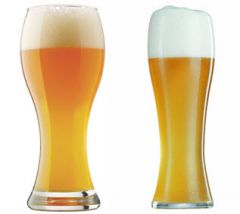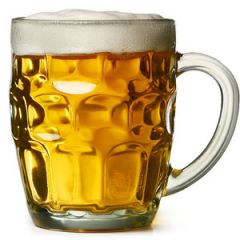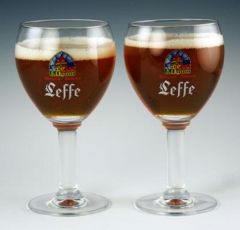![]()
![]()
![]()
Use LEFT and RIGHT arrow keys to navigate between flashcards;
Use UP and DOWN arrow keys to flip the card;
H to show hint;
A reads text to speech;
14 Cards in this Set
- Front
- Back
|
Vase Glass |

The tall and curvy glass commonly used for German Weizens and American wheat beers. The large size holds a lot of foam. |
|
|
English Dimpled Pint |

A short round mug used for English session beers such as milds and bitters. The cut lens design plays with the light and color of the beer. The handle keeps you from warming the beer with your hand. |
|
|
Snifter |
Glass that originally became popular for brandy, but is truly ideal for strong ales. It allows full contact with the hand, warming the glass as it's held. It concentrates the aroma at the nose and is appropriately small for the high ABV beer. |
|
|
English Tulip pint |
Recommended for Irish Stouts such as Guinness |
|
|
What is a nucleation site? |
Bubbles form at nucleation sites in the glass and travel to the head. Nucleation sites can be dirty spots, microscopic rough spots, or even purposefully laser drawn designs in the bottom of the glass. |
|
|
Tapered Pilsner Glass |
This "V" Shaped glass has a narrow shape that shows off the beer's pale color (a big deal when pale beers first appeared!) The outward taper supports the head, the foot is elegant, and they have an art deco look because they became popular in the 1930's |
|
|
Pokal Glass |

This is a small glass with a short stem and straight tapered sides. It is classic for bocks. |
|
|
Bolleke Goblet |

This fairly typical goblet glass not unlike a snifter. Similarly, it is appropriate for strong beers and concentrates aroma thanks to its inward taper. It is famous in Antwerp, Belgium and often has a small ball on the stem. |
|
|
Stemmed Tulip |
The glass commonly associated with Belgian specialty beer. The inward taper holds the beer's aroma, while the outward taper at the to supports the head and makes it east to drink from. |
|
|
Shaker Pint |
The typical American pint glass. |
|
|
Nonic imperial pint |
The typical British pint glass with the bubbled out section under the rim that makes them easy to stack, prevents chipping of the mouth, and provides for a better grip. |
|
|
How do you prepare glassware for serving beer? |
1) The glassware should be at room temperature (or slightly cooled by a quick rinse before pouring). Frozen or frosted glassware is not recommended because icy nucleation sites will cause over foaming. 2) A cold water glass rinse before dispensing beer aids in getting the glass beer clean before removing residual sanitizer and dust. |
|
|
Bavarian Seidel |
The large tall dimpled German mug perfect for low alcohol German session beers such as Pilsners, Helles, or Marzen. They are essentially a glass copy of large ancient stone mugs that were used for centuries. |
|
|
|
|

